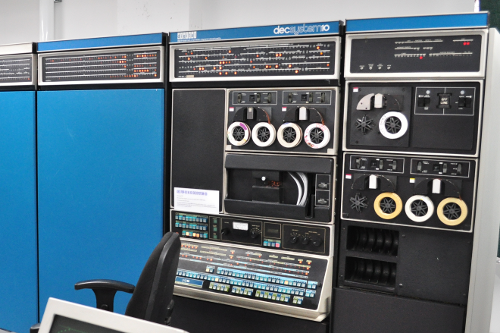The DEC PDP10

Originally the DEC PDP10 computer started as the PDP6. This was a 36 bit computer that was designed for timesharing, which was introduced in 1964. The original goal of the machine was to allow for processing of many 6 bit characters at a time. 36 bits were also common in machines like the IBM 7090, GE 645, and Univac 11xx lines. Several systems influenced the design of the original design, like CTSS, Lisp, support for larger memory. The PDP6 was canceled by DEC due to production problems. The engineers designed a smaller replacement, which happened to be a 36 bit computer that looked very much like the PDP6. This was called the PDP10. Later renamed to "DECSystem-10". The system supported up to 256K words of memory.
The first PDP10 was labeled KA10, and added a few instructions to the PDP6. Both the PDP6 and PDP10 used a base and limit relocation scheme. The KA10 generally offered two registers, one of user data and the second for user shared code. These were referred to the Low-Segment and High-Segment, the High-Segment could be shared with several jobs. The next version was called KI10 for Integrated. This added support for paging and double precision floating point instructions. It also added 4 sets of registers to improve context switching time. It could also support up to 4Mega words of memory. Following the KI10 was the KL10 (for Low-Cost). The KL10 added double precision integer instructions and instructions to improve COBOL performance. This was the first version which was microcoded. The KL10 was extended to support user programs larger then 256k. The final version to make it to market was the KS10 (for Small), this was a bit-slice version of the PDP10 which used UNIBUS devices which were cheaper then the KL10 devices.
The original operating system for the PDP6/PDP10 was just called "Monitor". It was designed to fit into 6K words. Around the 3rd release Swapping was added. The 6'th release saw the addition of virtual memory. Around the 4'th release it was given the name "TOPS-10". Around this time BBN was working on a paging system and implemented it on the PDP10. This was called "Tenex". This was later adopted by DEC and became "Tops-20".
During the mid 60's a group at MIT, who where not happy with how Multics was being developed decided to create their own operating system which they called Incompatible Timesharing System "ITS", was a play on the original project called Compatible Timesharing System "CTSS". CTSS was implemented by MIT on their IBM 7090 as an experimental system that allowed multiple time sharing users to co-exist on the same machine running batch processing. Hence the term Compatable.
Also during the mid 60's a group at Stanford Artificial Intelligence Laboratory (SAIL), started with a version of TOPS-10 and heavily modified it to become WAITS.
During the 70's Tymshare starting with DEC TOPS-10 system modified it to support random access files, paging with working sets and spawn-able processes. This ran on the KI10, KL10 and KS10.
The PDP10 was ultimately replaced by the VAX.
